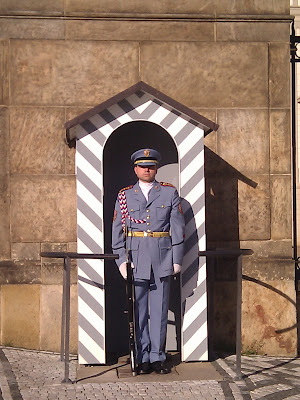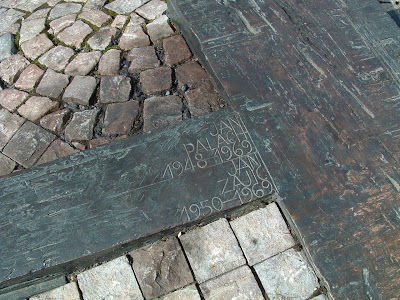We enjoyed our train ride from Berlin to Prague. We sat in the dining car and had goulash and beer, looking out the window as the train snaked alongside a winding river surrounded by wooded hills.
In Prague we changed our Euros for Czech currency, bought a street map, and set off on a trolley in search of our hotel, one of the few we had booked without any recommendation (only an online search).
Arriving at our stop, the street seemed suspiciously quiet. We finally found the address, but there was no visible sign that a hotel actually existed inside. A disheveled Czech woman answered the door and in broken english verified this.
She did however have the supposed owner's phone number, and thus began a search to meet the owner which had Kevin following medieval directions ("turn into the alley, look for the arch, go down the long stairs...") while Mary and Laura awaited his return.
Halfway down those long stairs was a bar where a kind bartender loaned me his cell phone. Resisting the temptation to have a strong drink then and there, I gratefully thanked him and, cursing the owner under my breath, resumed my search for her.
Long story short was that the owner, when finally tracked down, only had some fleabag room available for us (complete with unmade beds). On our way back to show Mary and Laura the room, we asked around, and were able to find a a different hotel. Our replacement hotel was quite nice (at some point in the past it was actually a part of the monastery further up the hill).
We celebrated by returning to the halfway-down-the-long-stairs bar for drinks. We looked out over the red roofs of Prague while listening to a recording of a Czech torch singer ("Hana Hegerova") playing over the sound system. (No idea what she was singing about but it certainly sounded dramatic).
The next day we walked down the hill through the labyrinth of streets and alleys that make up the Little Quarter.
We stopped for a treat. Couldn't pronounce the name of what we were eating ("Trdelnik")...
... but it sure was good.
Czech leaders have traditionally ruled from Prague Castle.
Live music for all tastes, from classical to BB King to Motorhead.
We didn't stop to try the cannabis or absinthe ice cream.
Near the river is a wall which became filled with graffiti following John Lennon's death in 1980. Every night the authorities would whitewash it off, and every day the graffiti would reappear. More than the death of a Beatle, it became a symbol of freedom during the Communist era.
Walking over a small bridge we came upon these locks. We saw the same thing in Paris. No idea what it symbolizes or why people feel compelled to leave a lock on a bridge.
The pedestrian-only Charles Bridge crosses the Vltava River and is a big tourist attraction, with lots of street artists, vendors, and crowds. The medieval-looking skyline of Prague is in the background.
On the east side of the river Prague is divided into "Old Town" and "New Town". Old Town is centered around a large square, an ancient marketplace dating from the 11th century.
This medieval clock from the 1500's marks the passage of time in an infinite (and confusing)
number of ways.
The "Communist Museum" shows what life was like during that era. Here for example is what you might see in a typical store (translation: not much).
Czech peasants marching in solidarity with their Russian brothers and sisters.
A statue of Stalin beams approvingly.
We have ways of making you talk.
Wencelas Square is the center of "New Town". "Good king Wencelas" was the Duke of Bohemia during the 10th century and became a symbol of Czech nationalism. This square was filled with thousands of demonstrators in the "Prague spring" of 1968, until Soviet tanks rolled in.
The National Museum sits at the top of Wencelas Square. The light-colored spots in the columns are patches from 1968 of Soviet bullet holes. Czech workers, ordered to fix the damage, intentionally chose the wrong color to make the patches stand out and memorialize what had occurred.
Jan Palasch was a philosophy student who set himself on fire in 1969 to protest the Soviet occupation. On the anniversary of his death 20 years later huge protests swept the city, culminating in the peaceful "Velvet Revolution" of November 1989, as hundreds of thousands of Czechs filled Wencelas Square each evening, demanding independence.
A beautiful city, free once again.

























No comments:
Post a Comment